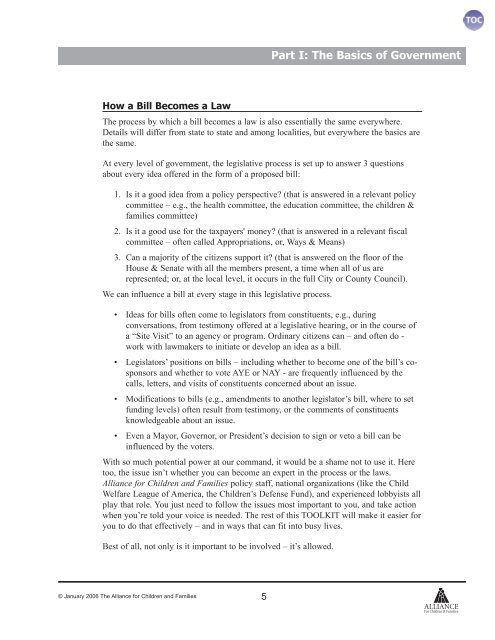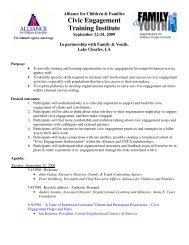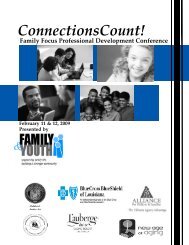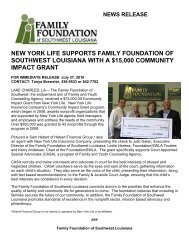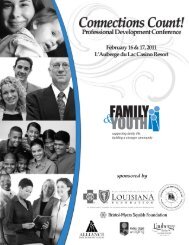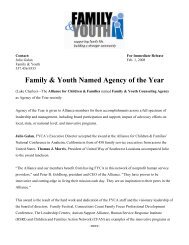Mission-based Advocacy Toolkit from Alliance for Children & Families
Mission-based Advocacy Toolkit from Alliance for Children & Families
Mission-based Advocacy Toolkit from Alliance for Children & Families
Create successful ePaper yourself
Turn your PDF publications into a flip-book with our unique Google optimized e-Paper software.
How a Bill Becomes a Law<br />
© January 2006 The <strong>Alliance</strong> <strong>for</strong> <strong>Children</strong> and <strong>Families</strong> 5<br />
Part I: The Basics of Government<br />
The process by which a bill becomes a law is also essentially the same everywhere.<br />
Details will differ <strong>from</strong> state to state and among localities, but everywhere the basics are<br />
the same.<br />
At every level of government, the legislative process is set up to answer 3 questions<br />
about every idea offered in the <strong>for</strong>m of a proposed bill:<br />
1. Is it a good idea <strong>from</strong> a policy perspective? (that is answered in a relevant policy<br />
committee – e.g., the health committee, the education committee, the children &<br />
families committee)<br />
2. Is it a good use <strong>for</strong> the taxpayers' money? (that is answered in a relevant fiscal<br />
committee – often called Appropriations, or, Ways & Means)<br />
3. Can a majority of the citizens support it? (that is answered on the floor of the<br />
House & Senate with all the members present, a time when all of us are<br />
represented; or, at the local level, it occurs in the full City or County Council).<br />
We can influence a bill at every stage in this legislative process.<br />
• Ideas <strong>for</strong> bills often come to legislators <strong>from</strong> constituents, e.g., during<br />
conversations, <strong>from</strong> testimony offered at a legislative hearing, or in the course of<br />
a “Site Visit” to an agency or program. Ordinary citizens can – and often do -<br />
work with lawmakers to initiate or develop an idea as a bill.<br />
• Legislators’ positions on bills – including whether to become one of the bill’s cosponsors<br />
and whether to vote AYE or NAY - are frequently influenced by the<br />
calls, letters, and visits of constituents concerned about an issue.<br />
• Modifications to bills (e.g., amendments to another legislator’s bill, where to set<br />
funding levels) often result <strong>from</strong> testimony, or the comments of constituents<br />
knowledgeable about an issue.<br />
• Even a Mayor, Governor, or President’s decision to sign or veto a bill can be<br />
influenced by the voters.<br />
With so much potential power at our command, it would be a shame not to use it. Here<br />
too, the issue isn’t whether you can become an expert in the process or the laws.<br />
<strong>Alliance</strong> <strong>for</strong> <strong>Children</strong> and <strong>Families</strong> policy staff, national organizations (like the Child<br />
Welfare League of America, the <strong>Children</strong>’s Defense Fund), and experienced lobbyists all<br />
play that role. You just need to follow the issues most important to you, and take action<br />
when you’re told your voice is needed. The rest of this TOOLKIT will make it easier <strong>for</strong><br />
you to do that effectively – and in ways that can fit into busy lives.<br />
Best of all, not only is it important to be involved – it’s allowed.


